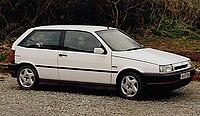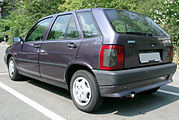Fiat Tipo (type 160)
| Fiat | |
|---|---|
|
Fiat Tipo five-door (1988-1993)
|
|
| Tipo | |
| Production period: | 1988-1995 |
| Class : | Compact class |
| Body versions : | Station wagon |
| Engines: |
Otto engines : 1.1–2.0 liters (40–107 kW) Diesel engines : 1.7–1.9 liters (43–66 kW) |
| Length: | 3958 mm |
| Width: | 1700 mm |
| Height: | 1445 mm |
| Wheelbase : | 2540 mm |
| Empty weight : | 905-1190 kg |
| Previous model | Fiat Ritmo |
| successor | Fiat Bravo / Fiat Brava |
The Fiat Tipo was a compact class car that Fiat produced for the European market between spring 1988 and late summer 1995 as the successor to the Fiat Ritmo . It was named Car of the Year 1989 because of the space it offers (max. Trunk with the rear bench seat folded down 1100 l, total interior 3700 l) and the innovative ideas at the time .
Model history
General
In March 1988 Fiat introduced a completely new compact car under the name Tipo . At first it was only available as a five-door hatchback sedan. It replaced the Ritmo that had been offered since the spring of 1978. The body was designed and developed by the then newly established external service provider I.DE.A Institute, whose first project was the Tipo.
From February 1990 the Tipo was also offered as a notchback and station wagon variant, which were called Tempra and Tempra Station Wagon and replaced the Regata .
After problems with corrosion in earlier models, Fiat built the Tipo with a partially galvanized body: a total of 23 m² of the vehicle sheet was galvanized, including the entire outer skin and all load-bearing parts. The tailgate was made of GRP . This not only served to prevent corrosion and save weight, but was also due to the extravagant shape, which at the time could not be made from sheet metal.
Furthermore, Fiat established a new strategy in the group with the Tipo. The Tipo shares almost the same floor assembly with different sister models . Depending on the model and engine, the same or a more detailed floor pan was used in the following vehicles:
Tempra, Coupe , Bravo , Brava , Marea , Lancia Delta II and Dedra , Lancia Lybra and Alfa Romeo 145 , 146 , 155 , Spider and GTV . Furthermore, it was, in turn, developed this floor module, the Alfa Romeo 147 / 156 / GT used.
This system prevailed to this day and was also used in other series, such as B. in the Fiat Croma (type 154) together with Alfa Romeo 164 , Lancia Thema and Saab 9000 .
The Tipo was equipped with different engines - with the output ranging from 40 kW (55 PS ) in the 1.1-l engine to the Tipo Sport with 107 kW (146 PS) from the 2.0-l 16V engine. There were also four diesel engines on offer, including two turbodiesel engines, each with a displacement of 1.9 l and outputs of 59 kW (80 PS) and 66 kW (90 PS), some of which already met the Euro 2 standard, as well as two naturally aspirated diesels with 1.7 l displacement and 42 kW (57 PS) and 1.9 l with an output of 48 kW (65 PS). The two 2.0-liter engines and the 1.8-liter 16V had two counter-rotating balancer shafts in order to match the smooth running of a six-cylinder engine. Some engine variants were not available in Germany and were only produced for the foreign market (such as the 1.1-l FIRE engine). The 1.4 l engine could be delivered with a CVT transmission (sales name “Selecta”) and the 83 kW 2.0 l 8V with a 4-speed automatic transmission.
A special feature of the Tipo was a load-dependent headlight level control which, unlike the Fiat Croma, was not controlled by a cable but by a hydraulic system. This system proved to be unsustainable because the pipes were made of defective plastic and the filling and ventilation openings were closed with simple steel bolts. After a few years the bolts burst into the plastic housing due to rust formation and made the system leaky.
Facelift
In the course of its construction the car was revised in detail. At the beginning of 1993 a modified Tipo u. a. with revisions to the front, dashboard and door panels, mechanical driver airbag and belt tensioner as well as improvements in the body strength in accidents, with which a three-door version of the Tipo was now available in addition to the five-door.
These changes were necessary, among other things, because the original version of the Tipo had proven to be extremely bad in a crash test. The body of the tested vehicle had almost completely collapsed on impact. For this reason, extensive reinforcements were added to the front of the car, which increased the weight of the Tipo by more than 50 kilograms without really improving the crash resistance. Even after these changes, the Tipo's passenger cell was relatively soft and offered little impact safety. The unsatisfactory crash safety and the changes that were made also affected vehicles derived from the Tipo, such as the Alfa 145, 146 and 155 series, which were also reinforced and considerably heavier without significantly increasing safety. Even the Alfa 156 still suffered from the inadequate accident safety of the Tipo platform and accordingly performed poorly in a crash test.
For the revised Tipo, the 1.4, 1.6, 1.8 and 2.0 l 16V machines have been improved in terms of injection and ignition systems due to the new emissions standard . With the facelift, the previously available digital speedometer was no longer available.
In October 1995 the Tipo was replaced by the Fiat Bravo and Fiat Brava , but production abroad continued until the end of 1999 (e.g. in Turkey and Brazil).
Engines
Gasoline engine
- 1.1 Fire, 1.1-l four-cylinder OHC with 1108 cm³ displacement and 41 kW (55 PS), 1988–1991
- 1400 ie, 1.4-l OHC four-cylinder with 1354 cm³ displacement and 52 kW (72 hp), 1988–1990
- 1.4 ie, 1.4-l OHC four-cylinder with 1372 cm³ displacement and 51 kW (70 hp), 1990–1995
- 1.6 ie, 1.6-l OHC four-cylinder with 1581 cm³ displacement and 55–57 kW (75–78 hp), 1990–1995,
- 1600 ie, 1.6-l-8V- DOHC four-cylinder with 1585 cm³ displacement and 66 kW (90 hp), 1988–1991
- 1.8 ie, 1.8-l-8V-DOHC four-cylinder with 1756 cm³ displacement and 66–77 kW (90–105 hp), 1992–1995
- 1.8 ie 16V Sport, 1.8-l 16V DOHC four-cylinder with 1756 cm³ displacement and 100 kW (136 hp), 1989–1992
- 2.0 ie, 2.0-l-8V-DOHC four-cylinder with 1995 cm³ displacement and 80–83 kW (109–112 hp), 1990–1991
- 2.0 ie 16V, 2.0-l-16V-DOHC four-cylinder with 1995 cc displacement and 102-107 kW (139-146 hp), 1991-1995
diesel
- 1.7 DS, 1.7-l four-cylinder naturally aspirated diesel with 1697 cm³ displacement and 43 kW (58 hp), 1988–1994
- 1.9 DS, 1.9 l four-cylinder naturally aspirated diesel with 1929 cc displacement and 48 kW (65 hp), 1991–1995
- 1.9 TD, 1.9-l four-cylinder turbodiesel with 1929 cm³ displacement and 59–66 kW (80–90 hp), 1990–1995,
Special models
- March 1990: "Series 6000" with electric window regulators, light metal rims, electronic central locking and electric sliding roof. Motorization: 1.4-liter petrol with 51 kW (70 PS) and 1.6-liter petrol with 66 kW (90 PS).
- May 1991: "Sound" with a Blaupunkt or Philips CD / stereo combination, aluminum rims, leather steering wheel and central locking. Engine: 1.6-liter petrol with 57 kW (78 PS) and 2.0-liter petrol (83 kW / 113 PS).
- February 1993: "Start" with 1.4-liter petrol engine (51 kW / 70 PS) and 1.9-liter diesel (59 kW / 80 PS)
- “Eleganza” with height-adjustable driver's seat with lumbar support and central armrest, infrared door lock and fog lights. Motorization like special model "Series 6000"
- "Sicura"
- "Progress"
- "Chic"
- "Roma"
Tipo 2.0 AGT / DGT
The Tipo 2.0 AGT / DGT has the 8-valve engine with two overhead camshafts and 83 KW / 113 PS. Its standard equipment includes central locking, electr. Front window lift, rev counter , power steering , ALB regulator , rear brake discs, tinted glass, asymmetrically divisible rear seat bench, 2 × three-point belts at the rear, tailgate handle with white "Granturismo" lettering, a so-called check control, information about the function of the lighting and open doors supplies, heated and electrically adjustable exterior mirrors. The AGT has an analog instrument panel and a digital one for the DGT. Additional accessories that can be ordered: 2 / 2- ABS from Girling, electric sliding glass roof , fog lights .
Tipo 2.0 GT TopClass
The TopClass special model includes, in addition to the already lavish standard equipment, a burgundy leather interior, air conditioning with recirculation flap, electr. adjustable and heated exterior mirrors, fog lights and aluminum rims. The Tipo TopClass was only delivered in silver and black metallic. In Austria this model was called VIP, with a sticker on the C-pillar
Tipo 2.0 ie 16V Sport
The 2.0 16V Sport is the top engine of the Tipo. The vehicle is driven by an engine with 1995 cm³ displacement, distributed over four cylinders with four-valve technology, controlled by two overhead camshafts. This engine also has piston crown cooling and an oil heat exchanger flushed with cooling water, which is supposed to warm up the oil at the beginning and cool it later. The latter fulfills this only more than moderately, which is probably a reason for the later failures of the connecting rod bearings and corresponding consequential damage. Almost the same engine can also be found in the Fiat Coupe 2.0 16V and the Lancia Delta II.
The equipment of the sport includes electric windows in front, electric. Sliding glass roof, heated electr. and painted exterior mirrors, central locking, side skirts, red decorative stripes all around, front bumper with large inlet and clear glass fog lights, sports grille, red tail lights, white front indicators, tailgate handle with red "SEDICIVALVOLE" lettering, (exclusively analog) sports speedometer with rev counter and oil pressure and temperature display, height-adjustable steering wheel, power steering , ALB controller , automatic load-dependent headlight height adjustment, manifold , sporty chassis, leather steering wheel from MOMO (from mid-1993 including airbag), sports seats, check control, color glazing, adjustable reading lamp and 15- Custom alloy rims (due to the larger brake system).
Alternatively, the car could also be ordered with sports seats from Recaro, which are characterized by a high backrest, small headrests and extendable leg rests with better lateral support. Additional accessories available to order: air conditioning, 4/4 ABS from Bosch, black leather interior.
Tipo Abarth
Officially no Abarth version was offered by Fiat, but there were some high-priced add-on parts, all of which were manufactured by the Zender company and offered by Fiat under the name "Abarth".





